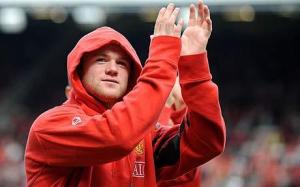In October 2010, Wayne Rooney announced he was leaving Manchester United because  the club could no longer attract star players in the transfer market. “I met with [United chief executive] David Gill last week, and he did not give me any of the assurances I was seeking about the future squad,” Rooney said. The news of Rooney’s impending departure triggered a frightening reaction: A mob of 40 fans clad in hoods and balaclavas gathered outside the gates of his Cheshire mansion, chanting insults and waving banners.
the club could no longer attract star players in the transfer market. “I met with [United chief executive] David Gill last week, and he did not give me any of the assurances I was seeking about the future squad,” Rooney said. The news of Rooney’s impending departure triggered a frightening reaction: A mob of 40 fans clad in hoods and balaclavas gathered outside the gates of his Cheshire mansion, chanting insults and waving banners.
Rooney’s concerns were completely legitimate; he just wasn’t the right person to voice them. Since losing Cristiano Ronaldo to Real Madrid, United had missed out on almost all of their top transfer targets: Franck Ribery, Karim Benzema, Wesley Sneijder. The fans who showed up at Rooney’s house were members of the Continuity Manchester Education Committee, a group of vigilante-activists who fought to prevent the Glazer family’s controversial 2005 takeover. They almost certainly shared Rooney’s apprehension about the club’s future. But Rooney – still recovering from a series of dreadful performances at the World Cup, as well as the public embarrassment of his second major sex scandal – lacked the moral authority to speak truth to the Glazers. (The tabloid rumors linking him with a big-money transfer to Manchester City didn’t help.)
Rooney eventually decided to stay at Old Trafford, thanks to the persuasive magic of a 160K-a-week contract offer. But his complaints about United’s transfer business marked a significant chapter in the club’s ongoing transition to the world of post-Sir Alex Ferguson soccer.
Unlike Chelsea manager Jose Mourinho, arguably the second greatest coach in the history of the Premier League, Ferguson never assembled a championship squad simply by purchasing talent on the transfer market. He constructed his best teams around a group of homegrown players – Giggs, Scholes, Beckham, Butt, the Neville brothers – cherry-picking talented young foreigners to bolster the rest of the lineup. Ferguson was never really an aggressive force in the transfer market (he recently told United’s in-house television channel that he didn’t enjoy negotiating moves), mostly because he never had to be: Anchored by the so-called Class of ’92, his squad always seemed to evolve organically, without the periodic spending sprees on which so many other clubs rely.
Ferguson’s strategy worked almost perfectly for about two decades. But the gradual decline of Giggs and Scholes, coupled with Ronaldo’s 2009 departure, presented a squad-building challenge that Ferguson never really addressed, despite steering two below-average teams to league titles in his last three seasons as coach. In 2012, after failing once again to lure Sneijder away from Inter Milan, Ferguson gave up on finding a long-term cure for the team’s limp midfield and instead convinced Scholes to come out of retirement.
As I pointed out in August 2013, long before the Old Trafford flyover and the derogatory banners, Ferguson’s handpicked replacement, David Moyes, wasn’t qualified to manage United. But to be fair, Moyes’ catastrophic failure was partly a result of the mess Ferguson left him: Aging players in key positions, disgruntled superstars on big salaries, no clear plan for the future.
It’s possible Ferguson convinced himself that the squad he coached to the 2012/2013 league title was good enough to keep winning trophies, even during a period of transition. Maybe Ferguson anointed Moyes his successor because he thought the former Everton coach was well equipped to shepherd an already-established lineup to further success. But United needed to rebuild – and Moyes, whose old-fashioned training strategies were never likely to entice big-name players, simply wasn’t famous or charismatic enough to secure his main targets.
The experienced, well-connected Louis van Gaal, who succeeded Moyes in the spring of 2014, is exactly the right person to conduct United’s much-needed overhaul. Earlier this week, Juan Mata, the one big name Moyes did manage to sign, told the BBC that United had been planning major changes since before Moyes’ firing. “They told me, ‘You are very important, you are one of the first,’” Mata said. “I knew the club was going to have these kind of signings.” Under van Gaal, United has finally executed the rebuilding project that Ferguson foolishly delayed. Ander Herrera and Daley Blind, signed last summer for modest fees, are flexible enough to play in multiple positions. And this summer’s recruits – striker Memphis Depay, right back Mateo Darmian, and central midfielders Morgan Schneiderlin and Bastian Schweinsteiger – will strengthen the squad in key areas.
United’s success this summer owes a lot to the fast-improving management of transfer czar Ed Woodward, whose poor planning last summer denied adequate pre-season training to van Gaal’s first round of marquee signings. Woodward has shown unexpected fortitude in recent weeks, playing hardball with Real Madrid over want-away keeper David de Gea and refusing to meet Valencia defender Nicolas Otamendi’s exorbitant buyout clause. Fans who turned against Woodward during Moyes’ season in charge are now tweeting about getting a tattoo of his face.
Meanwhile, Premier League analysts are busy speculating about United’s lineup for the new season. There’s some disagreement over the final composition of the back four – United is expected to buy another center back before the window closes – but many of the projected lineups share a striking similarity: Nine of the ten outfield players were signed after Ferguson retired. The one exception? Wayne Rooney.